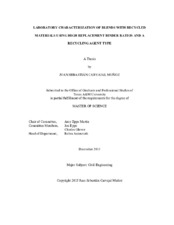| dc.description.abstract | The effects of using recycling agents (RAs) on hot mixture asphalt (HMA) have recently acquired special attention in the academic community due to the fact that recycled mixtures typically have high stiffness as a result of long periods of oxidative aging, mainly driven by environmental conditions (e.g., sunlight, temperature, and oxygen). In addition, the use of RAs in HMA aims at restoring the rheological and physicochemical properties of the aged binder contained in the reclaimed asphalt pavement (RAP) and reclaimed asphalt shingles (RAS) to provide the HMA mixtures with adequate performance, similar or superior to that of virgin HMA (i.e., without RAP, RAS, or RA). Subsequently, the objective of this thesis is to study the rheological and ageing characteristics of asphalt binder blends fabricated with RAP, RAS, and recycling agents using high recycled binder ratios (RBRs). The materials were retrieved from a recent field project constructed in Texas that incorporated high percentages of RAP/RAS materials with recycling agents and warm mixture asphalt additives in five highway sections. The laboratory characterization included: (1) blending charts, dosage estimations, and master curves from dynamic shear rheometer, (2) the Glover-Rowe (GR) parameter in Black Space diagrams, and (3) Fourier transform infrared spectroscopy (FTIR).
The results indicated that the use of the T1 recycling agent allowed for restoring the rheology (i.e., G* and phase angle) in all the combinations studied. Furthermore, validation of the regional linear blending concept allowed for calculating dosages of RA. The G-R parameter in Black Space diagrams showed that more than 40 pressure aging vessel (PAV) hours of artificial aging produce high stiff blends with high cracking susceptibility (i.e., damage zone between 180 kPa and 450 kPa). Furthermore, FTIR data showed a tendency of increase in the carbonyl area when using the T1 RA. Results include a suggested set of laboratory tools for characterizing binder blends, and a proposed methodology for determination of optimum dosages of RA in recycled mixtures with high RBR to be used in future research. | en |


